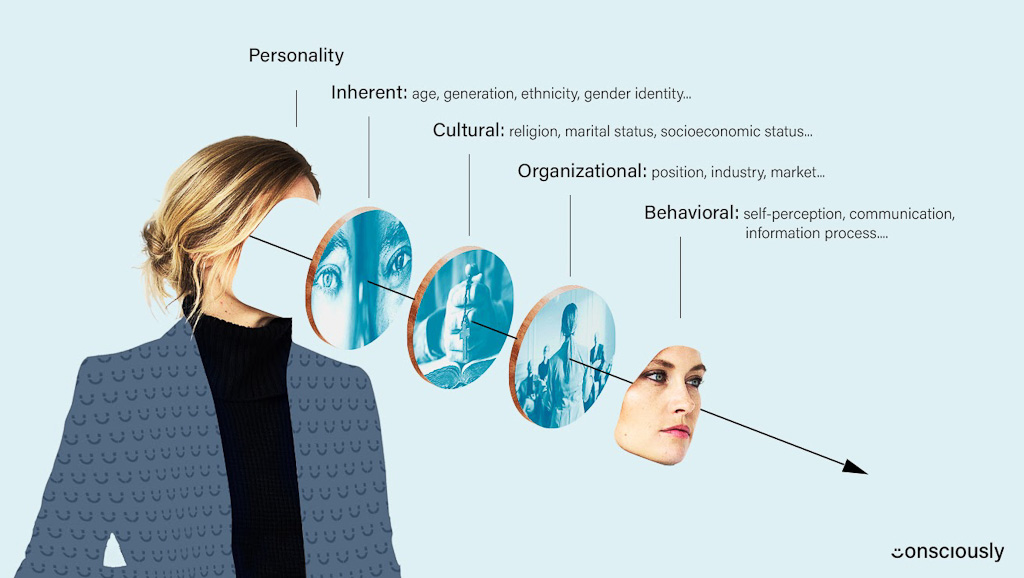What Is Behavioral Unconscious Bias?

in addition to our personality types, the way we behave can be a source of unwitting bias.
Here are examples:
- How we communicate: You might think you communicate inclusively and bias-free. You probably don’t. Inclusive language is visual or verbal communication that does not stereotype or demean people based on personal characteristics including gender, gender expression, race, ethnicity, economic background, ability/disability status, religion, sexual orientation, etc. Language is complex, but there are some basics to help you avoid bias in language.
- How we see ourselves as an individual: We can be biased, positively or negatively, about ourselves, and that affects us in the workplace. Self-serving bias, which casts ourselves in a completely positive light, hurts our ability to evaluate problems objectively.
But for minority job holders, negativity bias, in which we pay more attention to negative information than positive information, and building internal barriers can be much more common. These barriers include impostor syndrome, fear of missing out, fear of failure, minority stress, perfectionism, inability to self-promote, fear of judgment, and fear of vulnerability. Fortunately, there are ways to overcome a negative self-bias to set yourself on a path to realistic self-esteem for better effectiveness in the workplace.
- How we see ourselves in a group: In-group favoritism is a pattern of bias that favors members of your own in-group over others. At work, this could mean you evaluate someone of your religion more highly than someone of a different religion, or you advocate more for a job candidate who went to your college.
However, research has found that members of disadvantaged and minority groups are more likely than others to criticize members of their own group or culture. One theory to explain this is that people want to believe in the overarching social structure they’re part of, and thus feel they need to support the status quo.
- What we focus on: Focusing on the tasks at hand seems like the obvious way to get ahead at work, but ignoring or having a bias against relationship-building can be detrimental to success. Research indicates that minorities may be understandably reluctant to open up to others at work, since that requires trust.
- How we reach conclusions: Biases in how we think can affect our decision-making process. For instance, confirmation bias means we pay more attention to information that supports our beliefs than information that contradicts them, and the halo effect is when we believe someone must be good at many things, because we know they are good at one.
- How much we try to control: Yes, there’s such a thing as “control bias.” The illusion of control refers to the tendency for people to overestimate how much they can influence events. Even when it comes to random events, like the throw of a dice, people like to believe they have control. Learning what you actually control and what you don’t will improve your decision-making ability.
Minority group members tend to minimize discrimination and attribute their failure to themselves. This is an example of the illusion of control: They believe they have control over the outcome, when in fact the person doing the discriminating does. While minimizing discrimination is psychologically beneficial, it’s a perceptual failure.
While personal responsibility is vital, it’s important to recognize discrimination in the workplace, rather than feeling that you are completely responsible for how you are treated.
- How we see time: Does race impact time perception? While people may assume perceiving time is objective reality, research published in PLOS One finds that some white participants observing the faces of Black men perceived that more time had passed than when they looked at faces of white men. However, this only occurred among white participants who were concerned about appearing biased, perhaps because time seems to slow when we’re on alert or worried. The study’s authors write: “The more concerned one is with controlling the [racial] bias, the more likely this bias in time perception is to emerge.”
Other research has found that an interaction between a white person and a Black person puts the Black individuals on alert as well, due to concerns about being the target of bias or being treated in a stereotypical way. Thus it’s likely that Black people in these situations would also experience a bias to the way they perceive time








